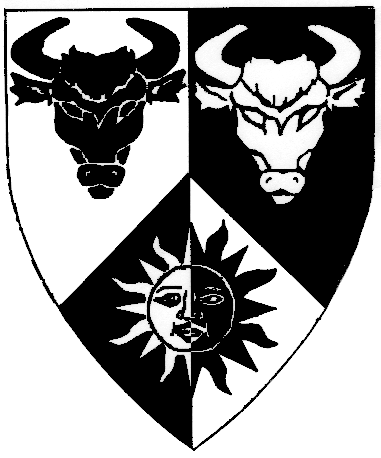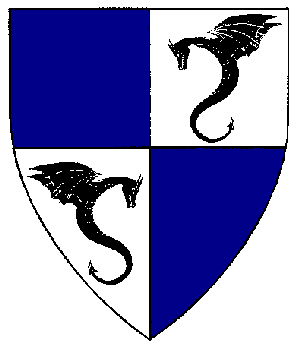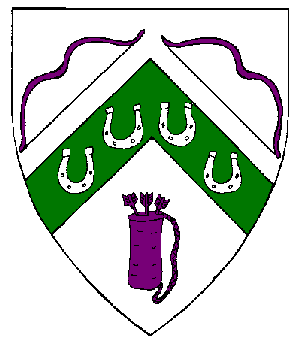1. Alesone inghean Torcail
Device Resubmission.
Per pall inverted argent, sable and purpure, two horses heads cabossed counterchanged and in base a sun in splendour Or.
This device was originally returned in March for a redraw as the line
of division was neither per pale and chevron nor per pale with a base.
This version corrects the problem.
The submitter's name appeared on Lochac's January 2006 LoI.

2. Aliénor of Essewell
New name submission.
The submitter seeks a feminine name and will not accept any changes.
She wishes her name to be authentic for the English language/culture.
Alienor appears as a variant of the name
Eleanor in Withycombe. This variant (along with
Eleanor and Elianor) is said to be a usual form of the name between
the 12th and 15th centuries. The spelling of the name including the
accent is cited only as the Provencal root of the name. We feel that
the name would be improved by dropping the accent, but must leave it
because of the submitter's requirements for no changes.
Essewell is found in Ekwall s.n.
Ashwell. It is cited as occurring in 1202. The name
is said to mean "Ash-stream".
3. Giles Leabrook
Blanket Permission to Conflict with Name.
Azure on a bend argent three roses azure barbed and seeded argent.
The submitter has included a letter that conforms to the standard
letter given in the Administrative Handbook. He additionally notes
that he grants permission for registration of names identical to his
registered name (should that ever become possible).
The submitter's name was registered in January 1989 via the West
Kingdom.
4. Griffin Westcastle
Device Resubmission.
Per fess indented sable and argent, on a pale counterchanged between two griffins argent a griffin argent.
This device was originally returned by Crux in March 2005 as the forms
were too low resolution, the emblazon was resized and the sable on
the device was an oddly tinted with green. This version is coloured
with texta and thus is free of the previous problems.
The submitter's name was registered in the July 2005 LoAR.
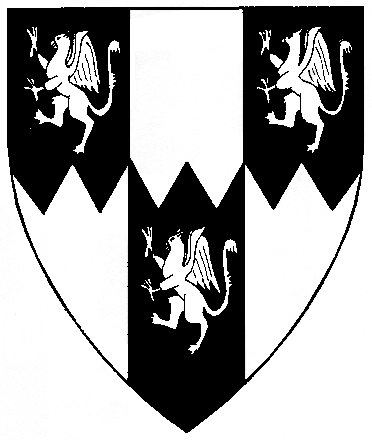
5. Roxana Grenelefe
New name and device submission.
Per pile throughout azure estencelly Or and argent, a vine leaf vert.
The submitter seeks a feminine name and will allow minor changes.
She makes no request for authenticity.
Roxana is the submitter's legal given name. She has
included a photocopy of her driver's license and wishes to register
this name element under the mundane name allowance.
Grenelefe is said to appear in Bardsley, though We
don't have copy of the book and thus can't check the citation.
Grenelefe also apparently also appears in Reaney and
Wilson, 3rd ed s.n. Greenleaf, where it is said to
have occurred in 1441. Sadly the Crux Australis library only includes
the 2nd edition of R&W (where it does not appear), so we can't check
that either. We will beg the College's indulgence in this matter and
send it up with this information that they may verify it for us.
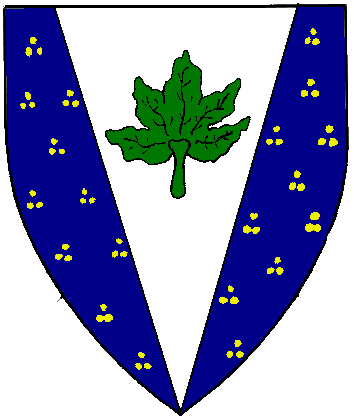
6. Torcail MacLeòid
Device resubmission.
Per pall inverted argent, sable and per pale sable and argent, two bull's heads cabossed and a sun in splendour counterchanged.
This device was originally returned by Crux in January 2005 as the
field division was neither per pale and per chevron no per pale with
a base counterchanged. This version has corrected the previous problems.
The submitter's name appeared on Lochac's January 2006 LoI.
